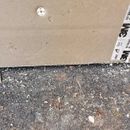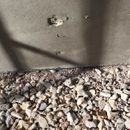Polyiso finish to grade?
Climate zone 6a, new home, pretty good house.
On the front of my home I have a thin rock veneer planned that goes from grade up to the start of the siding which I imagine is about 48″ above grade.
I have thought about the rock veneer and the problems with moisture in a 2×6 framed wall with 3″ of exterior fiber faced polyiso. My wall assembly for the rock area from inside to outside is Class III vapor paint > sheet rock > 2×6 wall > bibs cavity insulation > sheathing > 3″ fiber faced polyiso > house wrap > dimple matt drainage > fabric > lathe > stone.
The stone will come all the way down to grade. Grade will be 3 items, asphalt, soil and concrete patio. For now the installers have brought the polyiso all the way to about .25″ or maybe .5″ above grade. I’m concerned about the open unfinished edge of the polyiso getting wet and absorbing moisture. Should I be?
The pictures attached show the 3 different locations. Concrete is not yet poured as you can see the gravel. The gravel needs to be lowered because the concrete will not come above the polyiso.
What do you think. Do I need to have them stop the polyiso 6″ above grade and then fill the 6″ with EPS or something else?
Thanks,
Steve
GBA Detail Library
A collection of one thousand construction details organized by climate and house part












Replies
Hi Steve,
Sounds like you have a smart wall assembly planned. I think you are right to be concerned with the polyiso so close to grade. Even when used on basement walls inside, builders tend to hold polyiso up from the slab to reduce the risk of it getting wet, and it has more potential to get wet in your exterior situation. Perhaps a transition to another rigid foam type a bit higher on the wall would be a good idea.
Brian,
My wall assembly has be refined due to countless hours on here and the experts here provide valuable feedback so I'm glad you like the plan.
With respect to the Polyiso what are the implications if it does get wet? Does it degrade locally? Will the water wick to other parts of the polyiso?
You can see in one of the pictures the polyiso is already getting wet.
What are the chances of the polyiso getting wet when it is covered by house wrap, then dimple mat then the mortar that will stick the stone on will come all the way to grade and fill the gap between the polyiso and the grade?
Right now the polyiso comes down over about 6" of foundation wall to grade. I was thinking I should have them stop the polyiso about 5" above grade and then switch to 3" EPS down to grade.
Steve
Hi Steve.
I've heard a lot of mixed thoughts on how polyiso holds up to wetting. If you were installing it in a different situation, I might feel differently, but since you are installing it behind stone veneer where you may not know for a long time how it is holding up, it seems like it would be worth taking a cautious approach. Others may disagree, but if it were my house, I'd do something like you are suggesting, switching to EPS for at least a few inches from grade up.
Does anybody else have data on how polyiso might hold up in my situation and what the implications of it getting wet are?
If I were to cut out 5" of polyiso just above the grade and replace it with eps I'm not sure how is attach the eps. I suppose it would have to be glued to the foundation wall.
Steve
If the dimple matt drainage sheet is a vapor barrier (most are) the polyiso is never going to "see" the intense moisture drive from the masonry veneer. As long as there is at least some guaranteed air space between the polyiso and soil it won't/can't wick ground moisture. Even if it's only 0.25-0.5" of air it's a GREAT capillary break.
The key to it's performance over time is to keep it free of any debris that might cause it to wick moisture.
Sealing the cut bottom edges with an overlap of EPDM flashing tape would offer a good capillary break even at 0" clearance. That would easier to do if it were implemented while installing the polyiso. But there may be sufficient room to retrofit the tape after digging down the gravel. Be sure to properly lap the housewrap over the EPDM.
If you need to keep the bottom edge of the polyiso close to the ground and plan to put a strip of something else below it for protection, I’d cut the bottom of the polyiso at a bit of an angle, then cut the top of the lower “protection” insulation at a similar angle arrange so that the slope will drain the gap towards the outside of the wall. This way you minimize the chances of water getting trapped in the gap. You don’t want the polyiso sitting in a puddle.
In my experience, any gaps on the exterior of a structure tend to accumulate tree debris and insect nests. This stuff all works together to trap moisture so my concern with whatever you end up doing is to make sure it can’t get plugged up with moist debris, and make sure there is a drainage path. I don’t like exterior gaps with flat and level inner edges due to this issue.
Bill